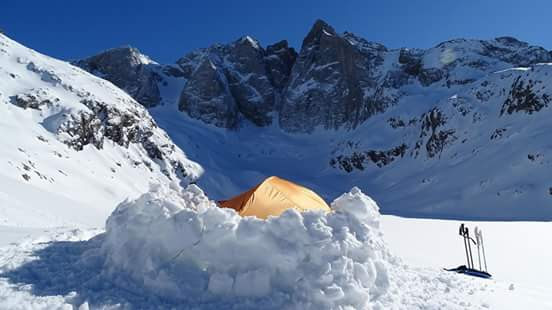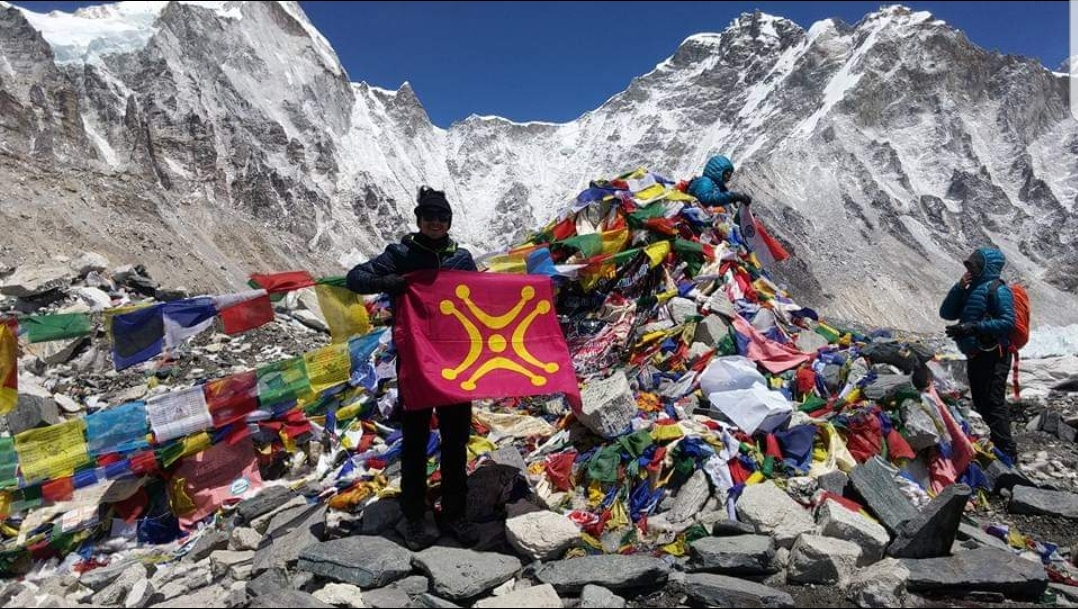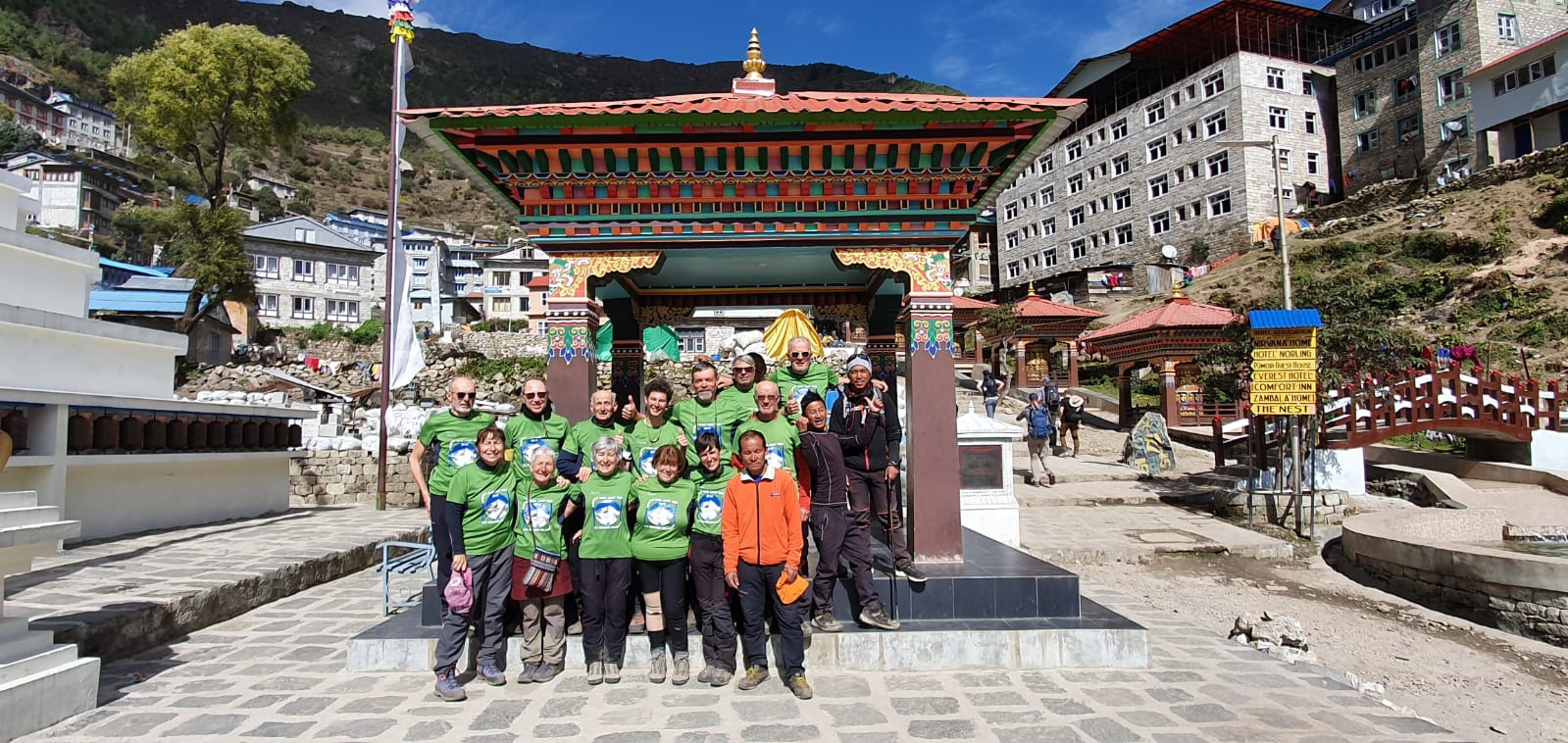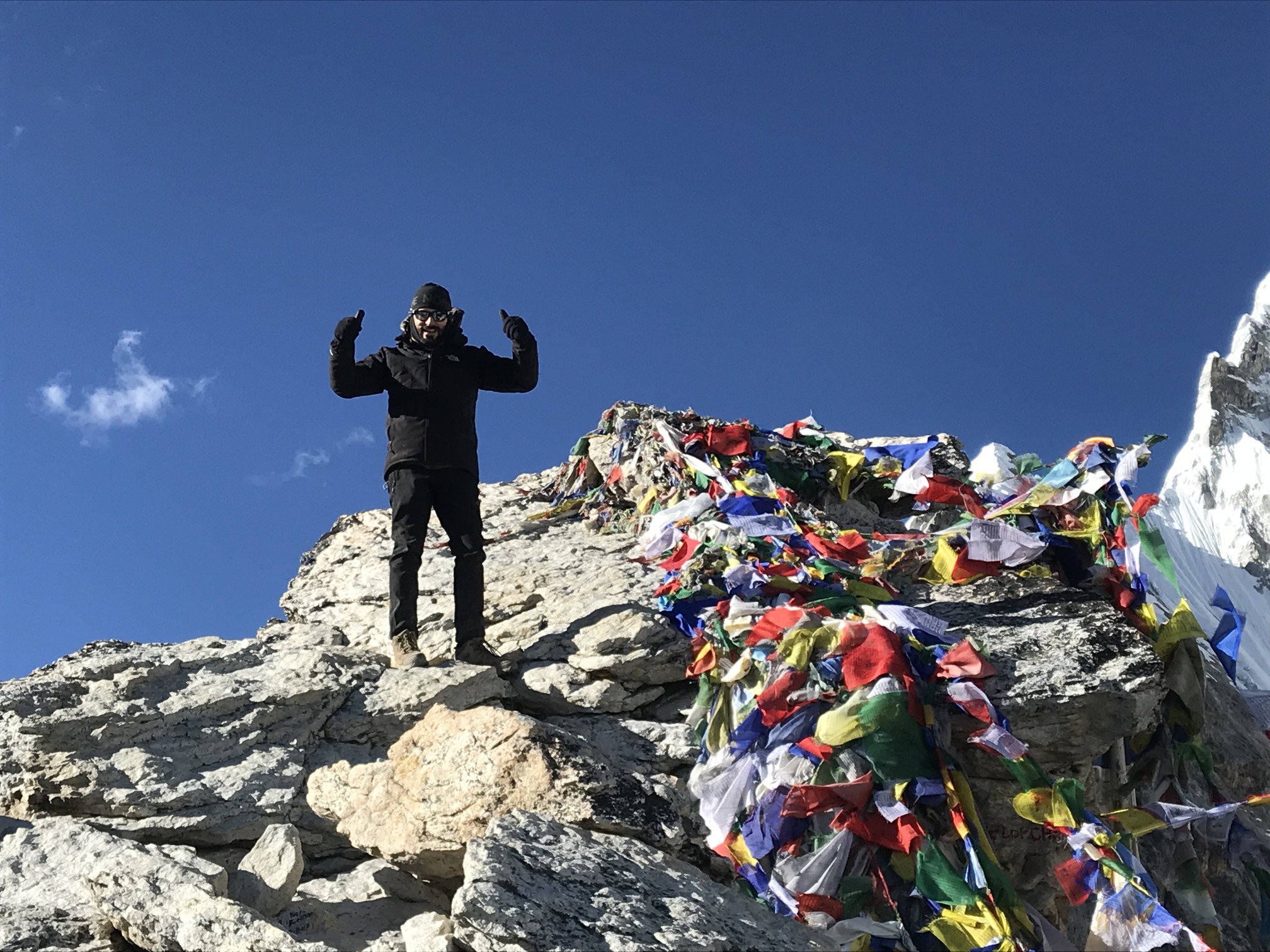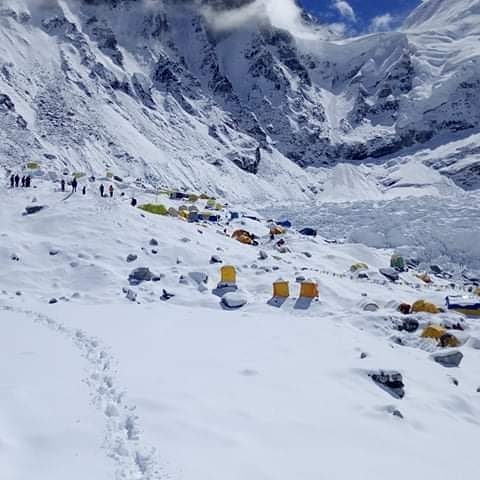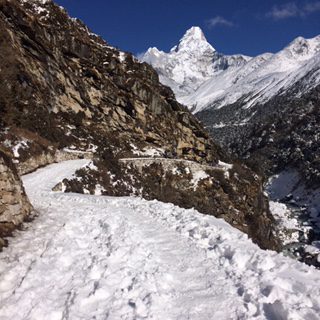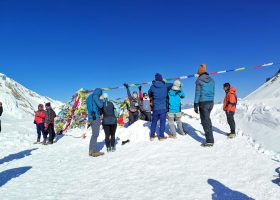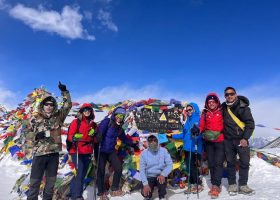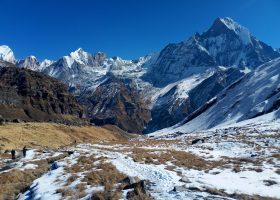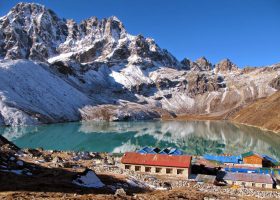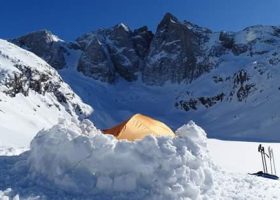Mera-Amphu Lapcha pass, Trek elevation 5,845 metres (19,177 ft), is a glaciated pass covered in serac cliffs at the head of the Honku Valley. It provides a way out of the otherwise relatively isolated Honku valley. The base of the valley is at 5,000 m (16,400 ft) and has several glacial lakes including the Panch Pokhri or Five Sacred Lakes. The Amphu Labtsa pass is crossed by mountaineers en route to Island Peak or Baruntse expeditions and involves technical mountaineering. The ice and rock summit is quite exposed and provides good views of Lhotse Shar, Island Peak and the Imja Glacier. The way down into the Imja valley on the other side of the pass involves abseiling followed fixed rope descent. The approximate alpine grade of the Amphu Labtsa pass would be ‘D’
Details Itinerary
Day 1 : Arrival in Kathmandu and Trip Preparation
Lorem Ipsum is simply dummy text of the printing and typesetting industry. Lorem Ipsum has been the industry's standard dummy text ever since the 1500s, when an unknown printer took a galley of type and scrambled it to make a type specimen book. It has survived not only five centuries, but also the leap into electronic typesetting, remaining essentially unchanged.
Accommodation : Tea House
Day 2: Drive to Pokhara
Lorem Ipsum is simply dummy text of the printing and typesetting industry. Lorem Ipsum has been the industry's standard dummy text ever since the 1500s, when an unknown printer took a galley of type and scrambled it to make a type specimen book. It has survived not only five centuries, but also the leap into electronic typesetting, remaining essentially unchanged.
Maximum Altitude :827m/2713ft
Travel Duration: 25 minutes flight /7-8 hrs. bus journey
Accommodation : Hotel
Meals :Breakfast
Day 3 : Trek to Ghandruk
Lorem Ipsum is simply dummy text of the printing and typesetting industry. Lorem Ipsum has been the industry's standard dummy text ever since the 1500s, when an unknown printer took a galley of type and scrambled it to make a type specimen book. It has survived not only five centuries, but also the leap into electronic typesetting, remaining essentially unchanged.
Maximum Altitude : 1940m/6365ft
Hiking :5-6 hrs.
Travel Distance: 10 km
Accommodation : Tea House
Meals :Breakfast, Lunch and Dinner
Day 4: Ghandruk to Chhomrong
Lorem Ipsum is simply dummy text of the printing and typesetting industry. Lorem Ipsum has been the industry's standard dummy text ever since the 1500s, when an unknown printer took a galley of type and scrambled it to make a type specimen book. It has survived not only five centuries, but also the leap into electronic typesetting, remaining essentially unchanged.
Maximum Altitude :2170m/7120ft
Hiking : 5-6 hrs.
Travel Distance: 12.5 km
Accommodation : Tea House
Meals : Breakfast, Lunch and Dinner
Day 5: Chhomrong to Bamboo
Lorem Ipsum is simply dummy text of the printing and typesetting industry. Lorem Ipsum has been the industry's standard dummy text ever since the 1500s, when an unknown printer took a galley of type and scrambled it to make a type specimen book. It has survived not only five centuries, but also the leap into electronic typesetting, remaining essentially unchanged.
Maximum Altitude :2310m/7579ft
Hiking : 5-6 hrs.
Travel Distance: 7.4 km
Accommodation :Tea House
Meals : Breakfast, Lunch and Dinner
Day 6 : Bamboo to Deurali
Lorem Ipsum is simply dummy text of the printing and typesetting industry. Lorem Ipsum has been the industry's standard dummy text ever since the 1500s, when an unknown printer took a galley of type and scrambled it to make a type specimen book. It has survived not only five centuries, but also the leap into electronic typesetting, remaining essentially unchanged.
Maximum Altitude :3230m/10598ft
Hiking : 5-6 hrs.
Travel Distance: 8.3 km
Accommodation : Tea House
Meals : Breakfast, Lunch and Dinner
Day 7 :Deurali to Annapurna Basecamp via Machhapuchre Basecamp
Lorem Ipsum is simply dummy text of the printing and typesetting industry. Lorem Ipsum has been the industry's standard dummy text ever since the 1500s, when an unknown printer took a galley of type and scrambled it to make a type specimen book. It has survived not only five centuries, but also the leap into electronic typesetting, remaining essentially unchanged.
Maximum Altitude :4130m/1355ft
Hiking : 5-6 hrs.
Travel Distance: 8.2 km
Accommodation :Tea House
Meals : Breakfast, Lunch and Dinner
Day 8 : Helicopter Flight from Annapurna Basecamp to Pokhara & Flight to Kathmandu
Lorem Ipsum is simply dummy text of the printing and typesetting industry. Lorem Ipsum has been the industry's standard dummy text ever since the 1500s, when an unknown printer took a galley of type and scrambled it to make a type specimen book. It has survived not only five centuries, but also the leap into electronic typesetting, remaining essentially unchanged.
Accommodation : Hotel
Day 9: Final Departure
Lorem Ipsum is simply dummy text of the printing and typesetting industry. Lorem Ipsum has been the industry's standard dummy text ever since the 1500s, when an unknown printer took a galley of type and scrambled it to make a type specimen book. It has survived not only five centuries, but also the leap into electronic typesetting, remaining essentially unchanged.
Cost Details
Cost Includes
- Airport to hotel pick and drop
- Two-night hotel in Kathmandu at three-star categories in BB plan
- Accommodation in Mountain lodge run by local people during a trek
- All meals during trekking
- One highly experienced mountain Guide and Porter
- Accommodation food, drinks, salary, insurance, transportation of both trek guide and Porter
- All necessary paper works and Sagarmatha National Park entry permit
TIMS Card (Trekker’s Information Management System card)
- Kathmandu/ Lukla / Kathmandu airfare.
Cost Excludes
- International airfare
- Travelers insurance
Cold drinks (Alcohol and cold drinks)
- Boiled water, Hot shower, Mineral water, Batteries charge and hot drinks (in pot)
- Lunch and dinner in Kathmandu (Approx. 10-12 USD
Map
FAQs
-
Clothing & Equipment
-
Acclimatisation & Oxygen
-
Guides, Sherpas & Team Members
-
Health & Fitness
-
Communication & Electronic Devices
Will there be any access to a satellite phone? If yes then what would be the charges for usage?
Yes, most of our expedition guides take satellite phones and you are welcome to use these at wifi and local moble call Most often, your guide will post daily dispatches on the Nhh website in which your friends and family can follow your progress.I want to contact my friend or relative, who is on one of your trips, how can I reach them?
Many of our treks and climbs send daily internet dispatches, and we receive updates from our guides while they are in the field. The best place to reach a loved one is through our office.Will there be any power source for charging batteries, etc. available throughout the trek?
For lodge-bassed treks, many of the lodges have power available with typical Asian plugs (two nail like horizontal prongs) and offer to recharge for a fee.We can cater for special power requirements at an extra cost or advise on the purchase of a suitable personal solar charging system - please enquire with our office.
-
Insurance
-
Fees & Payments
-
Photography
-
Safety
-
Employment
Manual Notes:
PACKING HELP FOR TREKKING TOUR
Max. 13 kg weight for the porters/participants
Long trekking trousers, wind- and water-repellent
Functional shirt short-sleeved
Long-sleeved functional shirt
Fleece jacket or sweater
Trekking socks normal and warm
Functional underwear
Long underwear
Warm sleepwear
Clothing for the lodge
Wind and waterproof rain jacket
Down jacket (Primaloft) thin with hood
Down jacket warm with hood
Cap warm
Buff bandana / scarf
Coneflower / Cap
Gloves normal and warm
Trekking shoes ankle-high
Trekking sandals or sneakers for Teahouse
Category 4 sunglasses
headlamp
Sleeping bag
Drinking bottle, thermos bottle
trekking poles
spikes
Day pack, rain cover
packing bag
Plastic bag for documents ect.
Big bag or backpack
First Aid Kit…painkillers e.g. Ibuprofen, diarrhea and vomiting remedies, electrolytes, cold remedies, wound disinfectant, plasters, blister plasters
Sun protection face and lips with high SPF
Toilet paper
handkerchiefs
microfiber towel
ear plug
nail clippers
brush, comb
Wet cleaning wipes
hand disinfection
toothbrush, toothpaste
washing gel
face cream
lip care
power bank
Phone, charging cable, headphones
Camera, SD card, spare battery
E-reader, book, notebook, pen
passport
passport photos
cash, credit card
Document insurance for helicopter rescue and illness

